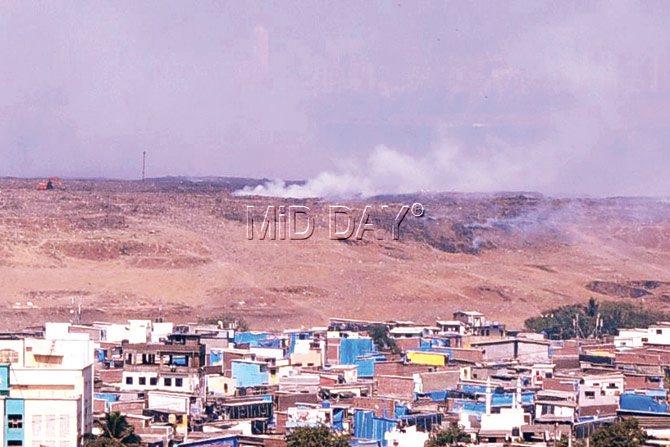So what if the city has failed to solve the Deonar problem? With the fame it’s brought us, perhaps it can be turned into a tourist attraction

 The Deonar dumping ground should be declared a monument. There ought to be audio-video tours, tickets, even merchandising booths selling T-shirts that read ‘I Survived Deonar.’ I suggest this for a number of reasons. To begin with, it deserves this honour because it has brought our city more fame than the many statues of dearly departed leaders our government puts up every other year.
The Deonar dumping ground should be declared a monument. There ought to be audio-video tours, tickets, even merchandising booths selling T-shirts that read ‘I Survived Deonar.’ I suggest this for a number of reasons. To begin with, it deserves this honour because it has brought our city more fame than the many statues of dearly departed leaders our government puts up every other year.
This fascinating, if smelly, suburb was recently captured by a NASA satellite, thanks to an inconvenient blanket of thick toxic smoke that made our poor air quality levels worse for over a week. The fire was an accident waiting to happen, of course. Everyone with half a brain knew that so, naturally, the state government didn’t. The Maharashtra Pollution Control Board reportedly sent eight notices to the BMC on its unscientific handling of waste, at least two years before the fire. These eight notices must have been rejected because they weren’t sent on the right kind of paper, perhaps. Or maybe they simply weren’t read because reading and writing have never been particularly high on the priority list of BMC employees.
ADVERTISEMENT

What a dump! The trash mountains at Deonar are as tall as 9-storey buildings, thanks to 5,500 metric tonnes of waste that replenish them every day. File pic
Many of us knew it was an accident waiting to happen because mountains of garbage don’t just disappear. One did, years ago on the Goregaon Link Road, but no one remembers that because the spot is now occupied by buildings whose residents have respiratory ailments and problems with their electronics but don’t want to complain because they paid a few crores for the privilege.
Deonar deserves to be a tourist attraction because it also says a lot about the famous spirit of Bombay that non-Bombayites always talk about whenever the odd manmade disaster or terrorist attack brings our city to its knees. It shows how residents of this city will live near, around, or inside a garbage dump simply because they can, even if it makes no sense whatsoever. These 326 acres of garbage also have their own mafia, apparently, with a number of major and minor gangs struggling for control of recyclable trash worth a reported Rs 60 lakh brought by trucks every day. If that expensive pile of trash is not selfie-worthy, what is?
The mountains here are as tall as 9-storey buildings, thanks to 5,500 metric tonnes of waste that replenish them every day. Yes, the Mulund and Kanjurmarg dumping grounds exist too, but they don’t break the rules with such staggering impunity the way Deonar continues to do, six years after it was officially set for closure. The Airports Authority of India mandated a 35-metre cap on garbage, but Deonar is already nudging the 55-metre mark, an interesting fact that ought to be mentioned prominently on the DeonarRocks.com website for tourists. Imagine the free publicity after a small aircraft is brought down by a heap of garbage — another minor accident probably just waiting to happen.
Another thing that ought to make Deonar an easy sell for Dark Tourism aficionados is how it has long been the site for so many human tragedies. I don’t mean tragedies involving the residents of Deonar. Their story is an old one, about always being at risk of developing chronic ailments and, eventually, a resistance to curative drugs. And yes, particulate matter can cause severe problems like asthma, bronchitis and tuberculosis, but so can any of our public hospitals, where cleanliness is not as important as how many flags of political parties the unions manage to put up.
According to data accessed by Safai Kamgar Vikas Sangh, a body representing sanitation workers, 2,309 conservancy workers engaged with the BMC died between 1996 and 2006 alone. That works out to around 20 casualties a month, without taking into account contract workers who obviously don’t matter. In 2011-2012, our city generated six per cent of the total waste generated in India. It boggles the mind that we still don’t have effective waste management systems in place. Apparently, what we do have are Municipal Solid Waste Rules that were formulated in 2000, most of which have failed to take off or are poorly implemented.
8,000 domestic industries and business delegates from 68 nations are supposed to participate in the Make in India week between February 13 and 18. I wonder what these guests will have to say about high-level emissions of greenhouse gases from our unsanitary landfills. I hope Deonar is on their list of sights. We should be proud of this monument and the incompetence for which it stands.
China can keep its Great Wall. We have our Great Dump.
When he isn’t ranting about all things Mumbai, Lindsay Pereira can be almost sweet. He tweets @lindsaypereira
Send your feedback to mailbag@mid-day.com
 Subscribe today by clicking the link and stay updated with the latest news!" Click here!
Subscribe today by clicking the link and stay updated with the latest news!" Click here!







